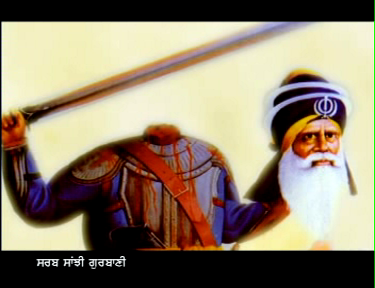The turban of a Sikh is a gift given on Baisakhi Day of 1699 by the Tenth Master, Guru Gobind Singh. After giving Amrit to the Five Beloved Ones, he gave us bana, the distinctive dress that includes the turban. It is helpful to understand the historical context of his action.
During Guru Gobind Singh’s time, the turban, or “dastar,” as it is called in Persian, carried a totally different connotation from that of a hat in Europe. The turban represented respectability and was a sign of nobility. At that time, a Mughal aristocrat or a Hindu Rajput could be distinguished by his turban. The Hindu Rajputs were the only Hindus allowed to wear ornate turbans, carry weapons and have their mustache and beard. Also at this time, only the Rajputs could have Singh (“lion”) or Kaur (“princess”) as their second name. Even the Gurus did not have Singh as part of their name, until the Tenth Guru.
The downtrodden followers of the Sikh faith did not have the means to display aristocratic attire, nor were they allowed to, even if they had the means. (Doing so was usually equivalent to a death sentence.) It was in this context that Guru Gobind Singh decided to turn the tables on the ruling aristocracy by commanding every Sikh to carry a sword, take up the name Singh or Kaur, and have kesh (hair) and turban displayed boldly, without any fear. This effectively made his followers see themselves on a par with the Mughal rulers.
When we are in the presence of the Guru, Guru is giving us the gift of his energy. That energy is sacred and when we retain it, Guru's energy lives in us and that gives us the living experience of Guru. To help retain that energy we cover our heads with a turban.
During Guru Gobind Singh’s time, the turban, or “dastar,” as it is called in Persian, carried a totally different connotation from that of a hat in Europe. The turban represented respectability and was a sign of nobility. At that time, a Mughal aristocrat or a Hindu Rajput could be distinguished by his turban. The Hindu Rajputs were the only Hindus allowed to wear ornate turbans, carry weapons and have their mustache and beard. Also at this time, only the Rajputs could have Singh (“lion”) or Kaur (“princess”) as their second name. Even the Gurus did not have Singh as part of their name, until the Tenth Guru.
The downtrodden followers of the Sikh faith did not have the means to display aristocratic attire, nor were they allowed to, even if they had the means. (Doing so was usually equivalent to a death sentence.) It was in this context that Guru Gobind Singh decided to turn the tables on the ruling aristocracy by commanding every Sikh to carry a sword, take up the name Singh or Kaur, and have kesh (hair) and turban displayed boldly, without any fear. This effectively made his followers see themselves on a par with the Mughal rulers.
When we are in the presence of the Guru, Guru is giving us the gift of his energy. That energy is sacred and when we retain it, Guru's energy lives in us and that gives us the living experience of Guru. To help retain that energy we cover our heads with a turban.



.JPG)


















 talk of the Sikh, he supported his head with his left hand and removing the enemies from his way with the strokes of his double-edged sword with his right hand, reached the periphery of Harmindar Sahib where he breathed his last. The Singhs celebrated the Diwali of 1757 A.D. in Harminder Sahib.
talk of the Sikh, he supported his head with his left hand and removing the enemies from his way with the strokes of his double-edged sword with his right hand, reached the periphery of Harmindar Sahib where he breathed his last. The Singhs celebrated the Diwali of 1757 A.D. in Harminder Sahib.